Punjab State Board PSEB 9th Class Science Important Questions Chapter 5 The Fundamental Unit of Life Important Questions and Answers.
PSEB 9th Class Science Important Questions Chapter 5 The Fundamental Unit of Life
Long Answer Type Questions
Question 1.
Describe the structure of the plant cell.
Answer:
A generalized plant cell consists of three distinct parts viz, cell wall, cell membrane or plasma membrane and protoplasm.
1. Cell wall. It is the outermost covering of a cell made up of a non-living substance called cellulose. Is is permeable. It provides shape, strength and protection to cell.
2. Cell membrane or Plasma membrane. It is thin, delicate and elastic protoplasmic covering lying internal to the cell wall. The plasma membrane controls the entrance and exit of molecules and ions.
3. Cytoplasm. It consists of a number of living and non-living structures. The living structures are called cytoplasmic organelles or cell organelles and include structures like endoplasmic reticulum, ribosomes, golgi apparatus, mitochondria, lysosomes, plastids, vacuoles etc.
(a) Plastids. Plastids are spherical or discoid bodies containing different types of pigments in them. They are of three types viz. chloroplasts, chromoplasts and leucoplasts. The chloroplasts contain a green pigment in them, called chlorophyll. They play a vital role in the process of photosynthesis. The chromoplasts contain pigments other than chlorophyll. They impart various colours to flowers and fruits. Leucoplasts are colourless plastids. They are concerned with the storage of starch.
(b) Mitochondria are power house of cell.
(c) Ribosomes are of 70 S type. They are site for protein synthesis.
(d) Endoplasmic reticulum is network of membranes.
(e) Vacuoles. These are fluid-filled bubble-like structures bounded by a membrane, called tonoplast. They are mostly found in plant cell. Vacuoles provide turgidity and rigidity to cell.
4. Nucleus. It is a dense spherical body bounded by a membrane, called nuclear membrane. Embedded within the nuclear sap are found a number of thread-like structures called chromosomes with genes on them. The nucleus controls the various metabolic activities of the cell.
![]()
Question 2.
Draw a well labelled diagram of ultrastructure of plant cell.
Answer:
Ultrastructure of plant cell
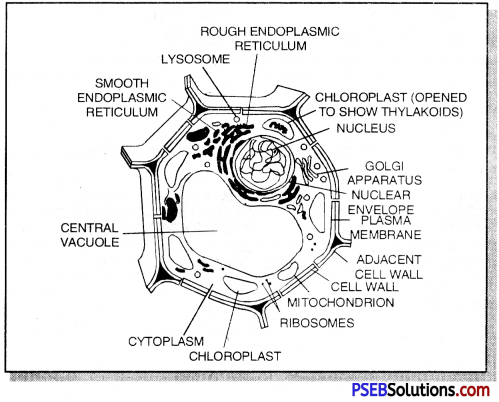
Question 3.
Describe the structure of nucleus. Write its functions.
Answer:
A true nucleus is present in all the eukaryotic cells except mammalian RBCs, sieve tube cells, tracheids and vessels. It directs life processes of cells. It is formed of four components:
(a) Nuclear membrane. It is a two-layered envelope around the nuclear sap. It is porous (with nuclear pores) and semipermeable membrane. Outer membrane is studded with ribosomes and may be continuous with RER. It regulates exchange of materials between nucleoplasm and cytoplasm.
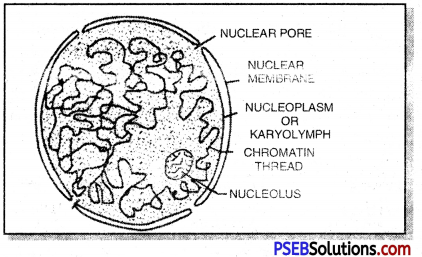
(b) Nucleoplasm. It is a semifluid colloidal substance in which nucleoli and chromatin fibres are present.
(c) Nucleolus. It is dense, spherical, naked and darkly stained structure and is the site of formation and storehouse of rRNAs.
(d) Ovomatin fibres. These are long, fine and darkly stained threads which collectively form nuclear reticulum. During prophase of mitosis and meiosis, these condense to form a species-specific number of rods, called chromosomes. These are with genes which are chemically formed of DNA and act as units of heredity and variations.
Functions of the nucleus:
The nucleus performs the following important functions:
- The nucleus controls all the cellular activities of the cell.
- Tire nucleus plays an important role in transmission of hereditary characters from parents to offsprings.
- The nucleus plays a vital role in cell division.
Question 4.
Write short notes on:
(a) Chloroplast
(b) Endoplasmic reticulum
(c) Golgi bodies
Answer:
Structure and functions of a chloroplast:
A chloroplast is formed of two membranes and two chambers, so resembles a mitochon-drion. Outer membrane is freely permeable while inner membrane is semi permeable. Inner chamber is filled with a denser and granular proteinaceous (about 50%) ground substance called stroma or matrix. It is site of dark reaction or CO2 fixation of photosynthesis and has a number of grana, 70 S ribosomes and DNA molecules (circular and naked).
1. Grana are site for light reactions of photosynthesis.
2. Function of Chloroplasts: These are sites of photosynthesis, so are called “kitchens of cell.”
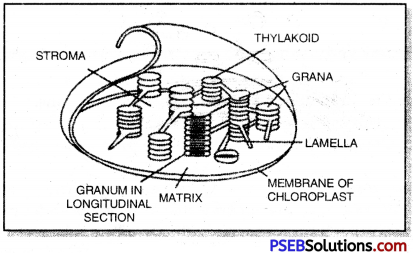
(b) Endoplasmic reticulum
There are two forms of endoplasmic reticulum. They are the following:
- Rough type (RER): Ribosomes are associated with rough endoplasmic reticulum.
- Smooth type (SER): Golgi apparatuses are associated with smooth endoplasmic reticulum.
Components of ER
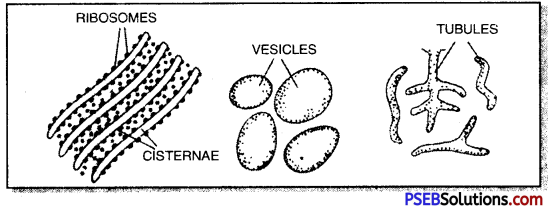
Functions of Rough and Smooth Endoplasmic reticulum
Functions of Endoplasmic Reticulum:
- The endoplasmic reticulum acts as secretory, storage, circulatory and nervous system of the cell. Its functions depend upon its location, nature and cell type.
- It provides an ultrastructural skeletal framework of the cell.
- ER provide channels for quick transport of materials.
- It provides surface for attachment of ribosomes.
- It provides materials, lipids and proteins for biogenesis of membranes.
Functions of Smooth Endoplasmic Reticulum:
- Detoxification of drugs and poison.
- Formation of visual pigment from Vitamin A in retinal cells.
- Synthesis of fats inside the cells of adipose tissue.
- Synthesis of steroids and hormones.
(c) Golgi complex or Golgi Apparatus:
The golgi complex is usually located near the cell nucleus and in animal cells it is frequently disposed around the centriole pair. It normally consists of numerous sets of membrane-bound, smooth surface cisternae. Each cisterna is flat, disc-shaped and curved like a shallow bowl.
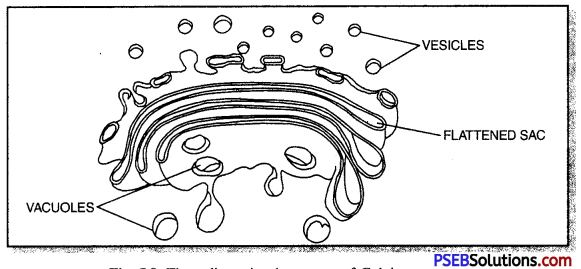
It has lumen which is bounded by a single membrane. Each set of flattened disc-shaped cistemae forms a structure that resembles stack of plates, called a Golgi stack or dictyosome (as referred in the plants).
![]()
Question 5.
Discuss the structure and function of mitochondrion.
Answer:
Structure. Mitochondria are ‘power house’ of cells. It has two mitochondrial membranes and two chambers. Outer mitochondrial membrane is smooth and porous while inner mitochondrial membrane is produced into finger-like processes called cristae to increase the surface area for the distribution of respiratory enzymes of electron transport chain.
Cristae are studded with regularly placed knob-like oxysomes which take part in energy releasing reactions. Inner chamber is filled with a granular matrix having respiratory enzymes. Matrix present in inner chamber also contains DNA, RNA and ribosomes.
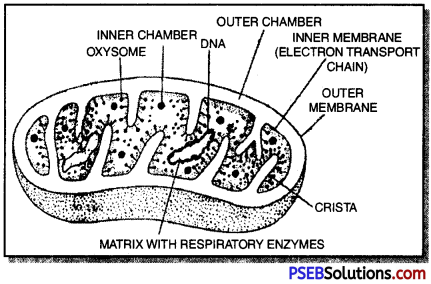
Functions of mitochondria:
- These are called power houses or power plants or ATP mills as these are site of aerobic oxidation (cellular respiration) of glucose to produce energy-rich ATP molecules.
- They provide biological intermediates for the synthesis of various biomolecules such as fatty acids, amino acids, steroids etc.
Question 6.
Write a note on prokaryotic cell.
Answer:
- The prokaryotes have a single membrane.
- Cells which have respiratory enzymes associated with plasma membrane.
- Circular DNA without proteins, forming a single prochromosome called nucleoid and lying in direct contact with cytoplasm.
- They have 70 S ribosomes.
- They lack membrane-bound organelles and sap vacuoles.
- They do not show cyclosis, phagocytosis, pinocytosis and exocytosis.
- Cell division by fission or budding.
- Examples. Bacteria, Blue green algae and Mycoplasma.
Question 7.
Write a short note on eukaryotic cell.
Answer:
- The eukaryotic cells have double membrane and plasma membrane devoid of respiratory enzymes.
- These cells have linear DNA associated with proteins forming two to many chromosomes enclosed by a nuclear envelope. Thus proper well defined nucleus is present.
- There are present 80 S ribosomes.
- Many membrane-bound organelles such as mitochondria, chloroplasts, lysosomes etc., and sap vacuoles present.
- Form mitotic apparatus in cell division and undergo meiosis.
- They may show cyclosis, phagocytosis, pinocytosis and exocytosis.
![]()
Question 8.
Draw the ultrastructure of a typical animal cell.
Answer:
An animal cell has three functional regions. Plasma membrane, cytoplasm and nucleus.
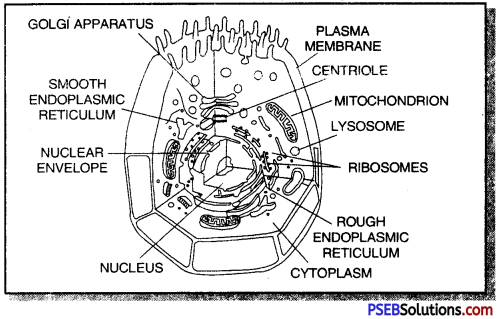
Short Answer Type Questions
Question 1.
What is cell and cell theory?
Answer:
Cell. 1. Structural and functional unit of life is called cell.
2. A cell is mass of protoplasm formed of different types of inorganic and organic biomolecules and externally bounded by a thin and semipermeable plasma membrane.
Cell Theory. M.J. Schleiden and Theodore Schwann (1938-39) proposed cell theory. The cell theory can be stated as follows:
(a) The body of all living organisms is composed of cells. Cell is a unit of structure and function of life.
(b) New cells are formed from the pre-existing cells only (R. Virchow).
(c) The life is passed from one generation to the next generation through a single cell.
Question 2.
What is a prokaryotic cell?
Answer:
Prokaryotic cell, (pro = primitive, karyon = nucleus) It is characterized by an incipient nucleus called nucleoid formed of single and circular chromosome. It is formed of double-stranded DNA but not associated with histone proteins. It is not enclosed by nuclear membrane.
- Membrane-bound cell organelles such as mitochondria, chloroplasts etc. are absent.
- Examples: Bacteria, Blue-green algae, Mycoplasma etc.
Question 3.
What is a eukaryotic cell?
Answer:
A eukaryotic (eu = good; karyon = nucleus) cell has true nucleus which has two or more linear chromosomes lying in the nucleoplasm and is surrounded by a double and porous nuclear membrane. Membrane bound organelles present. 80 S Ribosomes present (S = Svedberg unit).
![]()
Question 4.
Explain structural and functional organisation of unicellular and multicellular organism.
Answer:
- Unicellular organism, in such organisms, a single cell carries out all life processes with the help of organelles. They are also called acellular organisms.
- Multicellular organism. A multicellular organism is made up of large number of cells.
- The cells are differentiated to share varied functions performed by unicellular organisms. Whatever the case may be, all multicellular organisms start their life from a single cell.
- The multicellular organism represents itself in two forms – as an individual and as a member of assembly of cells.
- Advantages of Multicellularity:
- The division of labour in a multicellular organism increases the efficiency of the organism.
- It promotes the chance of survival.
Question 5.
What do you mean by:
1. Organelle
2. Inclusions
Answer:
1. Organelle, it is a living structure of cell with a specific function.
2. Inclusions. The lifeless structures in a cell, which may or may not have a definite function are called inclusions. These are vacuoles, excretory products, starch grains etc.
Question 6.
Distinguish between cell wall and cell membrane.
Answer:
Differences between cell wall and cell membrane
| Cell wall | Cell membrane |
| 1. It is present only in plant cells where it lies outside the cell membrane.
2. Dead in nature and permeable. 3. Composed of cellulose. 4. It is thick in nature. |
1. It ocurs in animal cells and plant cells.
2. Living membrane and is semi-permeable. 3. Composed of lipids and proteins. 4. Comparatively very thin. |
Question 7.
Name the two nucleic acids present in cell.
Answer:
- DNA (Deoxyribose nucleic acid): It is the genetic material. It is passed on from parents to next generation, It regulates the functioning of cells.
- RNA (Ribose nucleic acid): It is structural component of ribosome. It plays role in protein systhesis.
![]()
Question 8.
Why are mitochondria called “power house of cell”?
Answer:
Mitochondria are site of generation, transport and storage of ATP. Adenosine triphosphate (ATP) is the energy currency of the cell.
Question 9.
Explain lysosomes.
Answer:
- Lysosomes. They are single membrane bound vescicular structures. They are present in cytoplasm of eukaryotic cells. They contain digestive enzymes.
- They exist in four different forms thus exhibit polymorphism.
- They are involved in autolysis and hence called as ‘suicidal bags.’
Question 10.
List the functions of vacuoles.
Answer:
Functions of vacuoles
- They act as storage sacs for solid or liquid contents of cell.
- They help the cell to remain turgid and rigid.
- Vacuoles play an important role in growth.
- In some freshwater unicellular organisms, specialised vacuoles play an important role in expelling excess water and some wastes from, cells. It is called osmoregulation.
Question 11.
What is centrosome? List two functions of centrosome.
Answer:
Centrosome: It consists of granule like two centrioles; surrounded by clear area of cytoplasm called centrosphere. It is present in animal cells only.
Functions of centrosome:
- They help in spindle formation during cell divison in animal cell.
- They act as basal bodies and give rise to motile structures, i.e. cilia and flagella.
![]()
Question 12.
Differentiate smooth endoplasmic reticulum (SLR) and rough endoplasmic reticulum (RER).
Answer:
Differences between SER and RER:
| SER | RER |
| 1. It does not bear ribosomes over the surface of its membranes which are smooth.
2. It is engaged in the synthesis of glycogen, lipids and steroids. 3. It gives rise to sphaerosomes. |
1. It possesses ribosomes attached to its membranes which are rough.
2. The reticulum takes part in the synthesis of proteins and enzymes. 3. It helps in the formation of lysosomes through golgi apparatus. |
Question 13.
What are ribosomes? Write their kinds and chemical composition.
Answer:
Structure of Ribosome. The ribosomes are ribonucleoproteinic, obovate, spheroid without membrane structures. They are having two sub-units, one is larger sub-unit having dome-shaped structure and the other smaller sub-unit forming a cap-like structure. They are composed of ribosomal RNA (rRNA) and proteins.
Type of ribosomes:
1. 70 S ribosomes. They are present in both prokaryotic and eukaryotic cell.
2. 80 S ribosomes. They are present in eukaryotic cell.
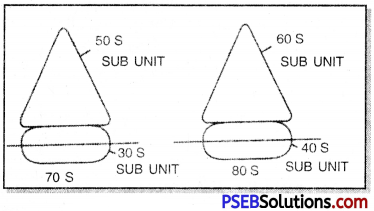
Functions of ribosomes:
They are the site of protein synthesis as they contain enzymes involved in protein synthesis.
![]()
Question 14.
Write functions of cell wall.
Answer:
Functions of cell wall:
- It provides shape and rigidity to the cell
- It protects the protoplast.
- It permits cells of bacteria, fungi and plants to withstand very dilute external environment without bursting.
- It increases the size of cell by continuous absorption.
- It is involved in the movement of materials in and out of the cell.
Question 15.
Give the functions of plasma membrane.
Answer:
Functions of plasma membrane:
- It maintains individuality of cells.
- It provides shape to the cell.
- It keeps the cell contents in place and distinct from the environmental materials.
- It protects the cell from injury.
- It regulates the flow of material into and out of the cell. It allows only the selected substances to move across it.
- It forms organelles of cell.
Question 16.
Define the following:
- Cytoplasm
- Hyaloplasm
- Nucleoplasm.
Answer:
- Cytoplasm: The clear, translucent, colourless, viscous, fluid in which are present various cell inclusions and organelles is called cytoplasm.
- Hyaloplasm: The clear homogeneous ground substance of cytoplasm is termed hyaloplasm (cytoplasmic matrix).
- Nucleoplasm: Clear transparent homogeneous fluid inside the nucleus is called ucleoplasm.
![]()
Question 17.
State the differences between cilia and flagella.
Answer:
Differences between cilia and flagella:
| Cilia | Flagella |
| 1. They are short hair-like structures with an average length of 5-10 mm.
2. They are present all over the surface of cell of the organism. 3. They are more in number usually 100 to a few thousand per cell. 4. They beat perpendicularly and simultaneously. 5. The cilia produce a sweeping or pendular stroke. |
1. They are long, whip-like structures with an average length of 150 mm.
2. They are usually present on one end of cell. 3. They are less in number usually 1 or 2 per cell. 4. They beat freely. 5. The flagella produce undulatory motion. |
Question 18.
State the differences between grana and stroma.
Answer:
Differences between grana and stroma:
| Grana | Stroma |
| 1. It consists of flatfened sac-like structures which are piled up one above the other like stacks of coins.
2. They contain photosynthetic pigments on them. 3. They are made of lipoproteins. |
1. It is matrix or ground substance of chloroplast in which different structures like grana and lamellae are embedded.
2. Pigments are absent. 3. It is composed of watery proteinaceous substance. |
Question 19.
Write functions of cell wall.
Answer:
Function of cell wall:
- It protects the cell from mechanical damage and infection.
- It helps in cell-to-cell interaction.
- It acts as a barrier to unwanted molecules.
- It provides rigidity and mechanical support to the cells.
![]()
Question 20.
How will you examine cells of onion peel.
Answer:
Examination of Onion Feel
- Take out the onion peel from the inner side of the scale of the bulb.
- Put this transparent peel into water and cut a small piece.
- Stain it with safranin solution. It will make the nucleus more distinct.
- Put it on the slide and place it in glycerine.
- Observe under low power microscope, then change it to high power and study the following:
Observation:
- Regular, rectangular-shaped cells are placed close to each other.
- Cell has a prominent cell wall, cytoplasm and nucleus. The vacuole occupies the central position.
Question 21.
What are possible shapes of cells? Explain with simple sketches.
Answer:
Shapes of cells
- Shapes of the cells differ not only in different organisms but also in different parts of same organism. They may be oval, spherical, discoid, cuboidal, columnar, spindle-shaped etc.
- The shape of the cell is usually related with its function.
- Some other factors controlling the shape of cell are function, age, pressure, cell wall and internal or external skeleton.
- Amoeba and leucocytes go on changing their shapes to enable them to engulf the materials.
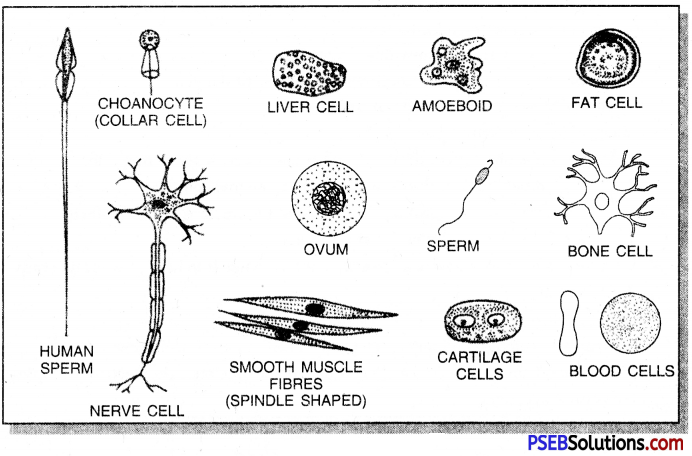
Question 22.
Differentiate between diffusion and osmosis
Answer:
Differences between diffusion and osmosis:
| Diffusion | Osmosis |
| 1. Diffusion is the net downward movement of a given substance (ions, atoms or molecules, etc.) along the free energy gradient from the place of its higher concentration to an area of its lesser concentration.
2. The diffusion may occur in any medium and the diffusing particles may be solid, liquid or gas. 3. Presence of semipermeable membrane is not required. |
Osmosis is a special type of diffusion of solvent molecules from low concentration of solution to higher concentration of solution when the two are separated by a semipermeable membrane.
2. The osmosis occurs in liquid medium and only the solvent molecules move from one place to another. 3. Presence of semi-permeable membrane in between the two solutions is required. |
Question 23.
Which organelle is called as protein factory of the cell?
Answer:
Ribosomes provide space for the synthesis of proteins in the cell. Hence, they are called protein factories. It synthesises various proteins and enzymes for the cell. Haemoglobin is an example of a protein made by free ribosomes in the young red blood corpuscles.
![]()
Question 24.
Differentiate Ribosome and Lysosome.
Answer:
Differences between ribosome and lysosome:
| Ribosome | Lysosome |
| 1. Ribosome is an oval to rounded granular structure which is not covered ever by any membrane.
2. It consists of two unequal nucieoprotein subunits. 3. It takes part in protein synthesis. |
1. Lysosome is a rounded membrane lined vesicle containing number of hydrolytic enzymes.
2. It does not consists of nucieoprotein. 3. It takes part in digestion, scavenging and defence against pathogens. |
Question 25.
What are plastids? Name its three types.
Answer:
Plastids. These are double membrane bound organelles found in plant cell. These are of three types:
- Chromoplasts
- Chloroplasts
- Leucoplasts.
Question 26.
Write functions of plastids.
Answer:
Functions of plastids
- Chloroplasts are the site of photosynthesis so called as kitchen of the cell.
- Chromoplasts provide colour to flowers and fruits.
- Leucoplasts are site of storage of food.
- Granum is site of light reaction, while stroma is the site of dark reaction.
Question 27.
What are the functions of lysosomes?
Answer:
Functions of lysosomes:
- Take part in intracellular digestion of foreign particle.
- They provide energy during starvation.
- They help in defence against bacterial and viral infection.
- Lysosome removes cellular debris.
Question 28.
Name the various organelles of cell and mention the most important function of each.
Answer:
Names and functions of cellular organelles:
| Name of cell organelle | Function |
| 1. Plasma membrane | Protects the cell organelles and separates the contents of cell from external environment. |
| 2. Cell wall (plant cell only) | Provides strength and rigidity to the cell. It permits the bacterial and plant cells to withstand very dilute external medium without bursting. |
| 3. Cytoplasm | Contains machinery and metabolites for carrying out the instructions sent from nucleus. |
| 4. Cytoplasmic matrix | Contains raw materials and enzymes for metabolism. |
| 5. Endoplasmic reticulum | It is responsible for transportation of extracellular and intracellular chemical molecules. It is also the site for synthesis of various molecules. |
| 6. Ribosomes | These are sites for protein synthesis. |
| 7. Golgi complex | Complexing, packaging and dispatching various materials to various targets inside and outside the cells. |
| 8. Mitochondria
|
Site for respiratory reactions and energy liberation in the form of ATP.
|
| 9. Lysosomes (animal cells only) Centrosome (animal cells only) Plastids (plants only). Cilia and flagella. Vacuoles. Nucleus. |
Helps in waste disposal system and autolysis. Forms spindle during cell division. Responsible for photosynthesis. Provide movement to cell. Storage sacs for liquid and solid contents. Regulates growth and reproduction of cell. |
![]()
Question 29.
Differentiate cytoplasm and nucleoplasm.
Answer:
Differences between cytoplasm and nucleoplasm
| Cytoplasm | Nucleoplasm |
| 1. Part of protoplasm that lies outside | 1. Part of protoplasm that lies inside the |
| 2. It appears to be homogeneous semi-fluid jelly-like substance | 2. It is transparent. |
| 3. It contains number of inorganic substances forming clear true solution and organic substances lipids, protein and carbohydrates forming a polyphasic colloidal system. | 3. Nucleoplasm is colloidal substance having similar composition to cytoplasm, but contains more of nucleo- tides. |
| 4. Suspended in it are various organelles and inclusions. | 4. Suspended in it is chromatin. |
Question 30.
What will happen to a cell if its nucleus is removed?
Answer:
Cell will die with passage of time as nucleus is the controlling centre of all functions of cell.
Very Short Answer Type Questions
Question 1.
What is the structural and functional unit of life?
Answer:
Cell.
Question 2.
Name three functional regions of a cell.
Answer:
- Plasma membrane
- Nucleus
- Cytoplasm.
![]()
Question 3.
Name the orgnelles present in the cells.
Answer:
Mitochondria, Ribosomes, Endoplasmic Reticulum, Golgi bodies, Centrosome, Lysosomes, Plastids.
Question 4.
Name the organelle present in plant cell only.
Answer:
Plastids.
Question 5.
What is the main component of nucleus?
Answer:
Chromatin network which takes up the shape of chromosomes at the time of cell division.
Question 6.
Give six examples of single celled organisms.
Answer:
Paramecium, Amoeba, Chlamydomonas, Euglena, Trypanosoma and Malarial parasite.
Question 7.
Who coined the term ‘Protoplasm’ for the fluid substance of cell?
Answer:
Purkinje (1839).
Question 8.
How it was made possible to observe the complex structures of cell?
Answer:
Discovery of electron microscope.
Question 9.
Name the organelle which takes part in protein synthesis.
Answer:
Ribosomes.
Question 10.
Which is the longest cell in plants.
Answer:
Sclerenchyma.
![]()
Question 11.
Name the smallest and largest cells.
Answer:
- Smallest cell – Mycoplasma.
- Largest cell-Ostrich egg.
Question 12.
Name the smallest and largest cell of human body.
Answer:
- Smallest cell – of kidney.
- Largest cell-neuron (nerve cell).
Question 13.
List the factors which denote size of cell.
Answer:
- Structure
- Location
- Function.
Question 14.
What are the two main components of protoplasm?
Answer:
Cytoplasm and nucleoplasm.
Question 15.
Which cell organelle is called suicidal bag?
Answer:
Lysosome.
Question 16.
What is the primary function of lysosome?
Answer:
A centre of intracellular digestion, so is called digestive bag.
Question 17.
Name the cell organelle responsible for protein synthesis.
Answer:
Ribosomes.
![]()
Question 18.
Expand DNA.
Answer:
Deoxyribose nucleic acid.
Question 19.
Expand RNA.
Answer:
Ribose nucleic acid.
Question 20.
Who examined thin slice of cork under microscope?
Answer:
Robert Hooke.
Question 21.
What is cork?
Answer:
Cork is obtained from the bark of a tree.
Question 22.
Who coined the term cell?
Answer:
Robert Hooke.
Question 23.
Who examined the living cells for first time?
Answer:
A.V. Leeuwenhoek.
Question 24.
What are unicelluar organisms?
Answer:
The organisms formed of single cell e.g. Amoeba.
![]()
Question 25.
What are multicellular organisms?
Answer:
The organisms formed of a large number of cells are termed as multicellular organisms e.g. human beings.
Question 26.
Write examples of multicellular organisms.
Answer:
Fungi, plants and animals.
Question 27.
Write two features of cells of onion peel.
Answer:
Presence of cell wall and large central vacuole.
Question 28.
What is the contribution of Robert Brown in cell biology?
Answer:
Discovered nucleus in the cells of orchid.
Question 29.
What are the two types of cells on the basis of nature of nucleus? *
Answer:
Prokaryotic and Eukaryotic cells.
Question 30.
Name any two prokaryotic cells.
Answer:
- Bacterial cell
- Blue-green algae
Question 31.
Who proposed the cell theory?
Answer:
M.J. Schleiden and Theodore Schwann.
Question 32.
What is cell theory?
Answer:
All plants and animals are made up of cells and cell is the structural and functional unit of life.
![]()
Question 33.
Give the contribution of Rudolf Virchow in the field of biology.
Answer:
He stated “omnis cellula e cellula” which means new cells are formed by the growth and division of pre-existing cells.
Question 34.
What is the number of cells present in an adult person?
Answer:
100 trillion (1014).
Question 35.
Which is the smallest measuring unit in the field of cell biology?
Answer:
Angstrom (A).
Question 36.
In which year electron microscope was invented?
Answer:
1940.
Question 37.
What is the nature of plasma membrane?
Answer:
It is formed of lipids and proteins.
Question 38.
Give the primary function of plasma membrane.
Answer:
It regulates exchange of materials between the cytoplasm and extracellular fluid.
Question 39.
Give one term for a semifluid ground substance present between plasma membrane and nucleus.
Answer:
Cytoplasm.
![]()
Question 40.
What is diffusion?
Answer:
Diffusion. The movement of substance from a region of higher concentration to a region of lower concentration is called diffusion.
Question 41.
What is the term for movement of water into and out of cell across a semipermeable membrane?
Answer:
Osmosis.
Question 42.
Define plasmolysis.
Answer:
Loss of water from a plant cell resulting in shrinkage or contraction of cell away from cell wall.
Question 43.
Give the common name of the mitochondria.
Answer:
Powerhouses or ATP mills.
![]()
Question 44.
Expand ATP.
Answer:
ATP. Adenosine triphosphate
Question 45.
Name two semi-autonomous cell organelles.
Answer:
Mitochondria and plastids.
Question 46.
Which type of enzymes are located inside the mitochondria?
Answer:
Respiratory enzymes.
Question 47.
Name the largest-sized cell organelle.
Answer:
Plastid (chloroplast).
Question 48.
Name three types of plastids.
Answer:
Leucoplasts, chloroplasts and chromoplasts.
![]()
Question 49.
Which cell organelle is called kitchen of cell and why?
Answer:
Chloroplast. It is site of photosynthesis in green plants. During this process plant prepare their own food by trapping solar energy and use COz and water as raw materials.
Question 50.
What are chromoplasts?
Answer:
These are coloured plastids with yellow, orange or red coloured plastids.
Question 51.
Write the chemical composition of cell wall.
Answer:
Cellulose.
Question 52.
What is the role of cell wall?
Answer:
Cell wall provide structural support to plant cell.
Question 53.
Which chemical is used to strain plant cell?
Answer:
Iodine, Safranin, methylene blue.
![]()
Question 54.
Give one major difference between SER and RER.
Answer:
SER is without ribosomes and is involved in lipid synthesis, while RER is with ribosome-studded cistemae and is involved in protein synthesis.
Question 55.
List two general functions of ER.
Answer:
- ER acts as channels for transport of materials within the cell.
- It also act as cytoskeleton.
Question 56.
Write one function of SER.
Answer:
Detoxification of many poisons and drugs.
Question 57.
Give the primary function of Golgi body.
Answer:
Cell secretion and acts as condensation membrane.
Question 58.
Which plastids are involved in storage of food?
Answer:
Leucoplasts.
![]()
Question 59.
What is the main difference between cell organelles and cell inclusions?
Answer:
Cell organelles are living structures of cytoplasm, while cell inclusions are non-living structures of cytoplasm.
Question 60.
Name the vacuolar membrane.
Answer:
Tonoplast.
Question 61.
Why is nucleus called director of cell?
Answer:
It controls and directs all the cellular activities.
Question 62.
Which organelle plays central role in cellular reproduction?
Answer:
Nucleus.
Question 63.
What is nature of nuclear membrane?
Answer:
It is two-layered, lipoproteinaceous, porous and semipermeable.
Question 64.
What is primary function of nuclear membrane?
Answer:
Regulates exchange of materials between nucleoplasm and cytoplasm.
![]()
Question 65.
What are the functional units of chromosomes?
Answer:
Genes.
Question 66.
What is the chemical nature of a chromosome?
Answer:
DNA and basic protein histones, so is called Deoxyribonucleoprotein (DNP).
Question 67.
Give the primary function of DNA of chromatin fibre.
Answer:
DNA acts as genetic material and helps in transmission of characters from par¬ents to offsprings.
![]()
Question 68.
What is the function of vacuole in plant cell?
Answer:
Vacuoles are full of cell sap and provide rigidity and turgidity to cell vacuoles, temporarily stores wastes.
Question 69.
Write functions of contractile vacuole in plant cell.
Answer:
Osmoregulation and expelling wastes from the cell.
Question 70.
Name the organelle which contains chlorophyll.
Answer:
Chloroplast.
Question 71.
What are two functions of plasma membrane?
Answer:
- Provides shape to cell
- Keeps intact the contents of cell.
![]()
Question 72.
What is osmosis?
Answer:
It is a special type of diffusion of solvent molecules from low concentration of solution to higher concentration solution separated by semipermeable membrane.
